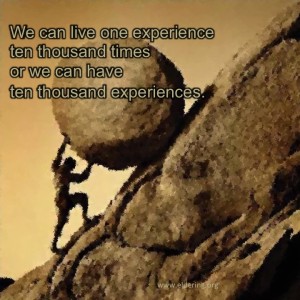 By Jim Selman | Bio
By Jim Selman | Bio
One of the toughest things we ever learn is to ‘let go’. I can’ t remember all the times I have made resolutions or tried to ‘reinvent’ myself or start over in one way or another. Every time we end a relationship or a job or some deeply ingrained habit (whether voluntary or involuntary) we must confront the break between the certain past and the possible future. And as far as I know there is no way to create and experience a ‘new’ future without letting go of the past.
But what does it mean to let go?
First we must ask what is ‘there’ to let go of. The past is made up of thoughts, feelings, embodied patterns, beliefs, moods, memories, and habits. Together they comprise the ‘story’ that we’re attached to and is, in most cases, bigger than we are. It is probably not an accident that we call the past history — HIS STORY. So the answer is that what we have to give up to let go of the past is our story — the nonstop narrative about the ‘way it is’, ‘what it means’ and ‘why everything is the way it is’.
But letting go of our story isn’t so easy.
The reason letting go can be difficult is that we actually believe that our story is true in the sense that it accurately describes what happened or what caused the present to be the way it is. If something in our story is not accurate then we believe just as fiercely that it must be false. What is not so evident is that while we can acknowledge poor memory or critique our analysis of why something happened or what it means, we rarely question our mega-belief that the past is the CAUSE of the present and therefore the future. This belief then becomes the basis or our practices of forecasting or predicting what will happen in the future and then organizing our actions and commitments around what we predict will happen.
For example when planning budgets in most organizations, the starting point is to project a trend to determine what we expect will happen in a year and then based on that forecast, plans are made and resources allocated to achieve a goal given that forecast. The results will inevitably validate the planners assumptions or when they are not forthcoming a plausible explanation of causality anchored in the past is required to keep the process going.
The result of this belief and associated practices is that we are continually living ‘into the past’ that we project as a prediction that in turn makes it virtually impossible to ever really let go of the past. This structure of thinking is tantamount to trying to get out of our own skin.
As we get older we need to appreciate that the more we let go the more time and experience we have left. I think that the key to ageing well and just about everything else in life is the ability to ‘be present’ to be fully ‘in the moment’. When we’re attached to our story or the past we are not present and time is always proportional to the past and how long we’ve lived. That is why a year can be forever for a child and is the blink of an eye for someone who is very old. When we are living in present time, then our experience is not related to anything else and is for all practical purposes ‘timeless’. As the old proverb goes, we can live one experience ten thousand times or we can have ten thousand experiences. The key is learning to ‘let go’ so that each day is a ‘new beginning’.
